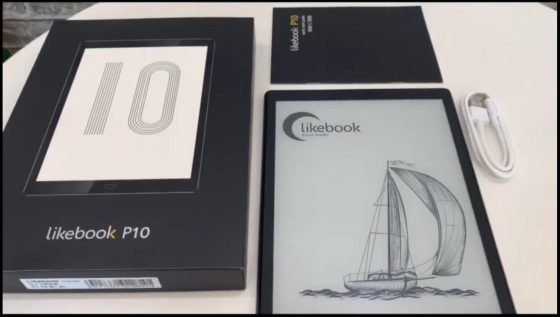Boyue recently released a new budget 10-inch ereader called the Likebook P10, and some early video reviews have started to turn up on YouTube.
The P10 is an unusual device because it has a different screen than all the other 10-inch ereaders on the market. Most have 10.3-inch E Ink screens with 227ppi, but the Likebook P10 uses a lower resolution 10-inch screen with 200ppi.
Considering it costs less that’s a comprise some might be willing to make, but hopefully this isn’t a sign of things to come—I’ve had enough with E Ink screens getting worse instead of better.
The device runs Android 8.1 and it can install Android apps. It even appears to have Google Play onboard.
As far as hardware specs go, it has a quad-core CPU with 2GB of RAM and 64GB of storage. It has a USB-C port, dual-band WiFi support, Bluetooth 5, and it has a frontlight with adjustable color temperature.
It uses a capacitive stylus instead of a Wacom touchscreen like other eNotes, so I wouldn’t expect the stylus to work very well. That’s probably why it wasn’t shown in the video review at all.
The built-in app supports ePub and PDF formats, among others, and it looks like they might have finally fixed the formatting issues with their built-in ebook app, but it’s hard to tell for sure since the books aren’t in English.
The price is only $339 but that’s without a stylus. Add another $25 for that. Unfortunately if you want to get a Likebook P10 the only way to currently do so is to order one from China through AliExpress. For some reason Boyue stopped selling their 10-inch Likebooks models on Amazon some time ago, but there are still several listings for their 7.8-inch models.


Thanks for the review. What about web browsing?
It has Carta, not Mobius screen and it scares me because its fragility.
If I buy a reflective screen, I think it’ll be an RLCD from Hisense if they improve its contrast or a TCL’S Nxtpaper if it’s better than RLCD now.
Didn’t Hisense already abandon their Q5 tablet? I don’t think there’s a market for monochrome LCD tablets on any level, and none of these alternative display technologies ever take off. Ten years of empty promises and still nothing useful. Whatever happened to ClearInk? For the past five years they’ve been saying they’ll have a product on the market “next year” and nothing ever happens. It amazes me how long some companies stay in business without ever producing anything.
What about its fragility? Yes, I know you won’t test it XD. Have you find out anything about it?
I don’t know. I don’t really pay much attention to stuff that’s only available in China or through shady resellers. If it becomes available on Amazon from a reputable seller I’ll buy one to review. If not, no big deal.
They publicize it as a toughened device
https://twitter.com/BoyueTechnology/status/1362196632448634881?s=20
Wow, here we go. For those of us who simply want an ereader for reading (and possibly for audio books) without all the bells and whistles is this step backward to 200 ppi a visual issue of significance? I am currently using a Likebook Mars (300 ppi) 7.8 inch screen and would love to move up to this unit which is much closer to my Nook HD+ 8.9 inch screen which was and still is my personal sweet spot as an avid reader. Two to three times a year, I still drag out the HD+ for a few weeks until my muscle memory reminds me how heavy that beast still is! If it wasn’t for the weight issue, I would still use it until it dies as it had/has such an excellent screen. I even replaced the original battery two years ago! Getting back to my original point: What impact on visual appearance (printed words) and potential eyestrain would the reduction from 300ppi to 200ppi have on extended reading times.? Does the increased screen size help offset the loss of ppi and (perhaps) less contrast? Also, for my highly targeted usage as an ereader only, I am very resistant when it comes to exceeding the mid to high $200.00 range for a unit and this is already well over the $300.00 mark. Would love to see a version without this one’s extras but with a 300ppi or higher simple touchscreen and wifi for the same or sub $300. price point.
It’s mainly going to come down to personal preference so the only person that can really answer is you. Higher ppi generally isn’t as important on larger screens because everything is scaled up and the device is usually held farther away. Personally I have no problem with 227ppi on other 10-inch screens. Either way I don’t recommend buying these kind of things from China because if there’s a problem it’s going to cost a fortune to send it back and they certainly aren’t going to pay for it, even if it’s defective.